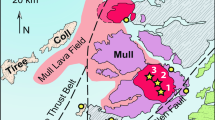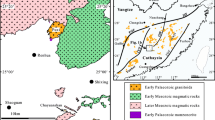Abstract
The Ascutney Mountain complex of eastern Vermont, USA, is a composite epizonal pluton of genetically related gabbro to granite intrusives. Nd isotopic data are reported for mafic rocks, granites, and nearby country rock. The parental mafic magma producing the complex 122 m.y. ago had 87Sr/86Sr=0.7039, 143Nd/144Nd=0.512678 (ɛ Nd=+3.8) and δ 18O=6.1‰, indicating a mantle source with time-integrated lithophile element depletion. Uniform initial radiogenic isotope ratios for granites, which are undistinguishable from those for the most primitive gabbro, suggest that the granite magma evolved from the mafic magma without crustal contamination and that the increase in δ 18O, to about 7.8‰, is the result of fractional crystallization. Mafic rocks show a large range in initial 143Nd/144Nd ratio, from about 0.51267 to 0.51236 (ɛ Nd= +3.7 to −2.5), which is correlated with elevated 87Sr/86Sr ratios and δ 18O. These data substantiate the production of mafic lithologies by fractional crystallization of the parental magma accompanied by assimilation of up to about 50% crust. The local country rocks include gneiss and schist and assimilation involved representatives of both rock types. The isotopic and chemical relationships preclude derivation from a single batch of magma undergoing contamination and indicate that a large magma body at depth evolved largely by fractionation with batches of melt issued from this chamber being variably contaminated at higher levels or at the level of emplacement.
The Precambrian gneisses of the Chester dome and overlying lower Paleozoic schists have essentially identical Nd isotope systematics which suggest a crustal formation age of about 1.6. b.y. The parental sediments for the schists were apparently derived from a protolith similar to the gneissic basement without appreciable Sm/Nd fractionation.
Similar content being viewed by others
References
Arndt NT, Goldstein SL (1987) Use and abuse of crust-formation ages. Geology 15:893–895
Barreiro B (1986) Sr- and Nd-isotopic studies of lower Paleozoic granitoids in the northern Appalachians. Terra Cognita 6:195
Chapman RW, Chapman CA (1940) Cauldron subsidence at Ascutney Mountain Vermont. Geol Soc Am Bull 51:191–212
Daly RA (1903) Geology of Ascutney Mountain, Vermont. US Geol Survey Bull 209:1–122
DePaolo DJ, Wasserburg GJ (1976) Inferences about magma sources and mantle structure from variations of 143Nd/144Nd. Geophys Res Lett 3:743–746
DePaolo DJ (1981) Trace element and isotope effects of combined wallrock assimilation and fractional crystallization. Earth Planet Sci Lett 53:189–202
Foland KA, Henderson CMB, Gleason J (1985) Petrogenesis of the magmatic complex at Mount Ascutney, Vermont, USA. I. Assimilation of crust by mafic magmas based on Sr and O isotopic and major element relationships. Contrib Mineral Petrol 90:331–345
Foland KA, Raczek I (1986) Nd isotopic evidence for contamination during genesis of syenites at Ascutney Mountain, VT. Abstracts with Programs, Geol Soc Am 18:603–604
Foland KA (1986) Mesozoic plutons of northeastern North America — Crustal contamination and mantle signatures. Terra Cognita 6:194
Goldstein SL, O'Nions RK, Hamilton PJ (1984) A Sm-Nd isotopic study of atmospheric dusts and particulates from major river systems. Earth Planet Sci Lett 70:221–236
Harrison TM (1986) Observations and controls on the occurrence of inherited zircons. Terra Cognita 6:193
Jacquemin H, Sheppard SMF, Vidal P (1982) Isotopic geochemistry (O, Sr, Pb) of the Golda Zuelva and Mboutou anorogenic complexes, North Cameroun: mantle origin with evidence for crustal contamination. Earth Planet Sci Lett 61:97–111
James DE (1981) The combined use of oxygen and radiogenic isotopes as indicators of crustal contamination. Ann Rev Earth Planet Sci 9:311–344
Lyons JB, Aleinikoff JN, Zartman RE (1986) Uranium-thoriumlead ages of the Highlandcroft Plutonic suite, northern New England. Am Jour Sci 286:459–509
Matsuhisa Y (1979) Oxygen isotopic compositions of volcanic rocks from the East Japan island arcs and their bearing on petrogenesis. Jour Volc Geotherm Res 5:271–296
McCulloch MT, Wasserburg GJ (1978) Sm-Nd and Rb-Sr chronology of continental crust formation. Science 200:1003–1011
Miller RG, O'Nions RK, Hamilton PJ, Welin E (1986) Crustal residence ages of clastic sediments, orogeny and continental evolution. Chem Geol 57:87–99
Muehlenbachs K, Byerly G (1982) 18O-enrichment of silicic magmas caused by crystal fractionation at the Galapagos spreading center. Contrib Mineral Petrol 79:76–79
Naylor RS (1975) Age provinces in the northern Appalachians. Ann Rev Earth Planet Sci 3:387–400
Nelson BK, DePaolo DJ (1985) Rapid production of continental crust 1.7 to 1.9 b.y. ago: Nd isotopic evidence from the basement of the North American mid-continent. Geol Soc Am Bull 96:746–754
Patchett PJ, Arndt NT (1986) Nd isotopes and tectonics of 1.9-1.7 Ga crustal genesis. Earth Planet Sci Lett 78:329–338
Patchett PJ, White WM, Feldmann H, Kielinczuk S, Hofmann AW (1984) Hafnium/rare earth element fractionation in the sedimentary system and crustal recycling into the Earth's mantle. Earth Planet Sci Lett 69:365–378
Schneiderman J (1987) Ascutney Mountain revisited: Petrology of the igneous complex and included breccia xenoliths. Ph.D. thesis, Harvard University, Cambridge Massachusetts, 286 p
Taylor HP Jr (1978) Oxygen and hydrogen isotope studies of plutonic granitic rocks. Earth Planet Sci Lett 38:177–210
Taylor HP Jr (1980) The effects of assimilation of country rocks by magma on 18O/16O and 87Sr/86Sr systematics in igneous rocks. Earth Planet Sci Lett 47:243–254
Wasserburg GJ, Jacobsen SB, DePaolo DJ, McCulloch MT, Wen T (1981) Precise determination of Sm/Nd ratios, Sm and Nd isotopic abundances in standard solutions. Geochim Cosmochim Acta 45:2311–2324
Author information
Authors and Affiliations
Rights and permissions
About this article
Cite this article
Foland, K.A., Raczek, I., Henderson, C.M.B. et al. Petrogenesis of the magmatic complex at Mount Ascutney, Vermont, USA. Contr. Mineral. and Petrol. 98, 408–416 (1988). https://doi.org/10.1007/BF00372361
Received:
Accepted:
Issue Date:
DOI: https://doi.org/10.1007/BF00372361




